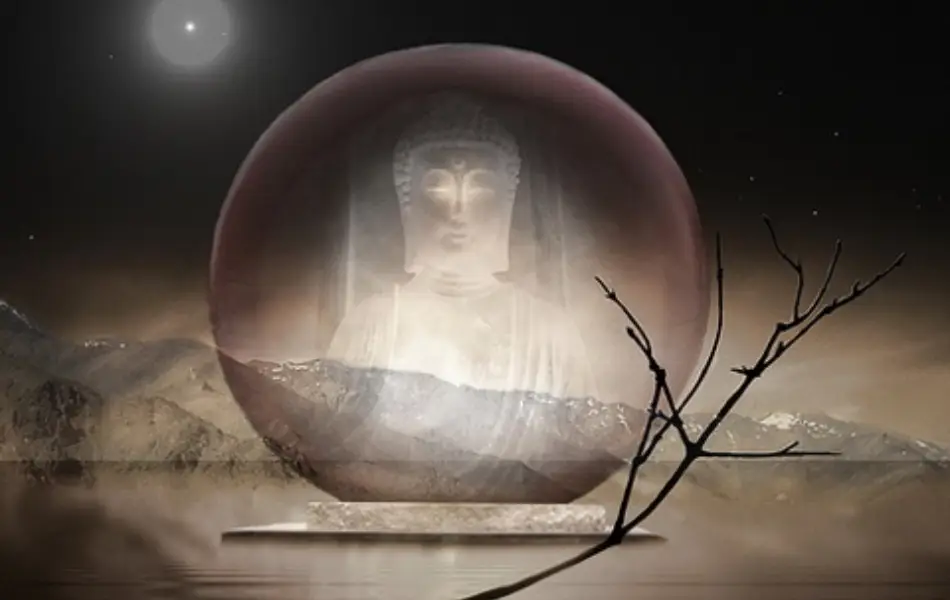Buddhist philosophy has a very meaningful saying: “Form is Emptiness and Emptiness is Form”. These iconic words come from the Heart Sutra, a highly revered scripture because it is said to contain the essence of Buddhism.
This statement was said by Bodhisattva Nagarjuna, a highly respected monk in Mahayana Buddhism. When scholars first heard this teaching of Nagarjuna, they found Buddhist teachings very difficult to understand. They find it contradictory because Buddhism discusses existence and non-existence together. Why do you say the shoe you’re wearing is nothing and nothing is also a shoe!
For them, Buddhism does not have a clear stance. However, they missed the deeper meaning behind that simple statement. They are not just about what is or is not there. It’s about understanding the nature of things in a way that goes beyond the usual black and white thinking.
Meaning of ‘Form is Emptiness and Emptiness is Form’
The phrase “Form is Emptiness and Emptiness is Form” is a central idea in Buddhist teachings, especially Mahayana Buddhism. From the Heart Sutra, a famous Buddhist scripture, it reveals the true nature of reality.
Simply put, “Form is Emptiness and Emptiness is Form” states that what appears to be matter or “form” is ultimately empty. The term “Emptiness” in this case does not mean nothing, but more precisely, nothing exists independently, everything is created by fate. Understanding this shows that matter and spirit, form and emptiness are not opposites but two sides of the same truth.
Here’s a breakdown of what it means:
- Form is Emptiness: This part suggests that the physical forms we see in the world, like objects, people, and even our own bodies, are essentially empty of inherent existence. In simpler terms, things don’t exist independently or in isolation. Their existence is interconnected, influenced by numerous causes and conditions. For instance, a tree’s existence is tied to sunlight, water, and soil. Remove these elements, and the tree as we know it ceases to exist.
- Emptiness is Form: This aspect might seem a bit more abstract. It means that this ’emptiness’ – the lack of independent existence – isn’t some void or nothingness. Instead, it is the very basis through which forms can exist. Emptiness allows for the flexibility and change we see in the world. It’s like the space in a room that allows it to be filled with furniture, people, light, etc.
We often view reality as separate things. But that is mistaken. Instead, it is all interconnected and fluid, not fixed and alone. Grasping this can deeply change how we see experiences. It makes us feel compassion and a oneness with everything around us.
Explain more about ‘Form is Emptiness and Emptiness is Form’
Everything we see around us is not permanent. Items like shoes, houses, or cars are temporary gatherings of different parts. They do not have a fixed essence that makes them what they are. When those parts come apart, the items no longer exist. Nothing has its own independent existence.
Consider a car. We think of it as a separate thing. A car is not a bicycle, right? However, if we examine a car closely, we realize it has no inherent “car-ness.” A car is essentially a collection of interconnected parts that we have agreed to call a “car.” But on its own, a car does not truly exist.
A flower does not have an independent existence either. A flower is the result of soil, water, sunlight, and air interacting together. It does not appear out of nowhere. It forms through various elements combining. The same is true for gold or diamonds. They arise through a series of conditions and processes over time. They are not simply present on their own. This view reveals an interconnected and ever-changing reality underlying the world around us.
But the car and the flower branch are still “Form”, still matter even if we break it down into atomic particles! So why is it called “Emptiness”?
“Emptiness” here does not mean non-existence in a nihilistic view. It means that there is no fixed self-nature, because there is nothing separate, self-contained, independent, so everything is affected by impermanence.
Think of it this way: Imagine a cup. It can be empty or filled with tea. But for it to be either, the cup itself must exist first.
This emptiness doesn’t suggest non-existence. Instead, it’s about transcending our usual ideas of existing or not. It’s about understanding that things don’t have a fixed, independent essence. When you really get into the heart of impermanence, non-self, and interdependence, you’re touching something profound, something absolute. It’s like getting a glimpse of Nirvana, the ultimate nature of reality.
Emptiness exists in all things and phenomena, allowing them to arise and cease. It’s this very nature of emptiness that lets the Buddha teach, “All things are subject to change.” It’s also what makes it possible to alleviate suffering through the Noble Eightfold Path and reach enlightenment.
If everything had a permanent, unchanging essence, they would exist in a static state, unformed and unaltered by anything. But this isn’t what we observe in the universe. That’s why the great Buddhist sage Nagarjuna concluded that Emptiness is the true nature of all things: no inherent self, no fixed identity, just a temporary coming together of conditions.
This temporary nature of things often leads us to cling to them, creating suffering when they inevitably change. “Oh no, the car I saved up for years is stolen! How can I cope?” Such attachments arise because we forget that everything is marked by impermanence from the moment of its creation. Loss is inevitable; it’s just a matter of when.
So, does this mean everything is doomed to destruction from the start? Should we give up on life, our homes, wealth, or love, as they’ll all vanish eventually? Should someone in suffering end their life in hopes of a better rebirth?
Not so fast. Remember, rebirth is governed by Karma. If you don’t work to change your negative state now, the next life might be even more challenging. Losing a car is painful, but it’s a chance to see beyond the loss. If we didn’t have ‘Form’ in ‘Emptiness’, we’d be stuck without that car forever.
Without Form in Emptiness, we wouldn’t exist at all – no Earth, no Sun, no cars. Everything arises and ceases due to conditions; it’s the law of existence.
How to apply ‘Form is Emptiness and Emptiness is Form’ in everyday life
To apply the teaching “Form is Emptiness and Emptiness corresponds to Form” to your daily life, first grasp its core idea: realize how everything is connected and impermanent.
- Interconnectedness in Daily Interactions: Acknowledge that your existence is not isolated. Every action you take, word you say or thought has ripples far beyond the present moment. When you interact with someone, remember that you are not just dealing with their current appearance or mood, but also with an organism shaped by countless factors, many of which cannot see. This perspective cultivates compassion and patience.
- Perception of Objects and Situations: See the things around you, not just as isolated entities with intrinsic value or identity but as manifestations of countless causes and conditions. Your car, your phone, your home—they all exist in their current form due to myriad factors and will change or cease to exist under different conditions. This understanding helps you attach less and appreciate more, reducing suffering tied to loss and change.
- Self-reflection and Identity: Consider your own identity. You perceive yourself as a fixed entity with certain characteristics, yet you are constantly changing, influenced by your experiences, thoughts, and interactions. Realizing this makes it possible to be less rigid in defining yourself and others, promoting growth and freedom from limiting self-concepts.
The teaching of ‘Form is Emptiness, and Emptiness is Form’ isn’t about giving up on life. It’s about a balanced view of life. It teaches us not to cling to changes, whether good or bad. It’s about not getting stuck in the negative, not being upset by today’s weather or life’s unpredictability. It helps us not to get attached to the false views that our mind tricks us into every moment. Everything is a result of causes and conditions. Good actions lead to good outcomes. Tomorrow is a new day, and who knows what the tide will bring?








